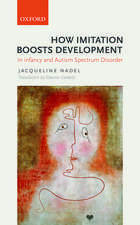Measuring Behavioral Health Outcomes: A Practical Guide: Clinical Child Psychology Library
Autor Robert P. Hawkins, Judith R. Mathews, Laureen Hamdanen Limba Engleză Hardback – 31 mar 1999
| Toate formatele și edițiile | Preț | Express |
|---|---|---|
| Paperback (1) | 364.53 lei 6-8 săpt. | |
| Springer Us – 31 mar 1999 | 364.53 lei 6-8 săpt. | |
| Hardback (1) | 371.10 lei 6-8 săpt. | |
| Springer Us – 31 mar 1999 | 371.10 lei 6-8 săpt. |
Preț: 371.10 lei
Preț vechi: 390.63 lei
-5% Nou
Puncte Express: 557
Preț estimativ în valută:
71.01€ • 74.34$ • 58.76£
71.01€ • 74.34$ • 58.76£
Carte tipărită la comandă
Livrare economică 05-19 aprilie
Preluare comenzi: 021 569.72.76
Specificații
ISBN-13: 9780306460807
ISBN-10: 0306460807
Pagini: 191
Ilustrații: XIV, 191 p.
Dimensiuni: 155 x 235 x 16 mm
Greutate: 0.48 kg
Ediția:1999
Editura: Springer Us
Colecția Springer
Seria Clinical Child Psychology Library
Locul publicării:New York, NY, United States
ISBN-10: 0306460807
Pagini: 191
Ilustrații: XIV, 191 p.
Dimensiuni: 155 x 235 x 16 mm
Greutate: 0.48 kg
Ediția:1999
Editura: Springer Us
Colecția Springer
Seria Clinical Child Psychology Library
Locul publicării:New York, NY, United States
Public țintă
ResearchCuprins
1. Why Get Quantitative Outcome Information on Clients?.- Benefits of Using Direct, Continuous Measurement.- Questions about Data Collection and Graphing.- Purpose and Organization of This Book.- 2. Targeting Behaviors to Measure and Change.- First Tasks of Clinical Services.- Determining Who Should Collect Quantitative Information.- Guide for Getting Children and Parents Started Collecting Quantitative Information.- Selecting Target Behaviors or Environmental Events to Measure and Potentially Change.- 3. Defining and Measuring Target Behaviors.- Define the Target Behaviors and/or Environmental Events.- Decide How to Measure the Behavior and/or Environmental Events.- 4. Using Checklists and Rating Scales.- Checklists.- Rating Scales.- When to Measure.- Conclusion.- 5. Arranging the Data in Graphs.- Arranging Quantitative Clinical Information for the “Consumers”.- Characteristics of a Graph.- Methods of Graphing.- Summary.- 6. Engaging the Child and Family in Collecting and Using Clinical Data.- Establish a Therapeutic Alliance with the Child and Family.- Maintain Recording by Family Members.- Summary.- 7. Interpreting Data.- Characteristics to Look for in the Data.- Conclusion.- 8. Troubleshooting the Problems.- Problem: Adult Fails to Collect the Clinical Information.- Problem: Child or Adolescent Fails to Collect Data as Requested.- Problem: Adolescent or Parent Loses Data Sheets at Home.- Problem: Parent or Adolescent Forgets to Bring the Data to Their Appointment.- Problem: Data Collector Is Estimating or Is Recording Data Right before Sessions.- Problem: The Child, Adolescent, or Parent Has Insufficient Skill or Motivation.- Problem: The Recording Task Is Difficult.- Problem: The Child, Adolescent, or Parent Reading Skills Are Limited.- Problem: The ParentCannot Afford Some Item Needed for Recording.- Concluding Remarks.- 9. Case Illustrations.- Case #1 : 8-Year-Old Boy with Encopresis.- Case #2: 14-Month-Old Boy with Sleep Problems.- Case # 3: 3-Year-Old Girl with Aggression and Noncompliance.- Case #4: 13-Year-Old Girl with Recurrent Abdominal Pain.- References.- General Forms.- ABC Recording Forms.- Frequency Recording Forms.- Duration Recording.- Interval/Momentary Time Sampling Recording.- Checklists.- Rating Scales/Quality Recording.- Cue-Effectiveness Recording.- Miscellaneous Other Forms.
Recenzii
`...the book is an excellent addition to the field. It surpasses other efforts of a similar nature in its readability, its comprehensiveness, and its vitality. My recommendation to all readers- read it and use it; you will love it!'
Saul Axelrod, Temple University
Saul Axelrod, Temple University




















